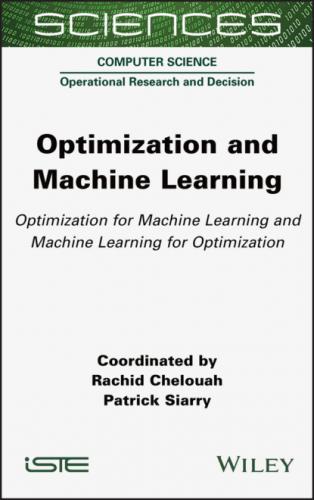8 Index
List of Illustrations
1 Chapter 1Figure 1.1. An example of a 2L-CVRP solutionFigure 1.2. An example of a 3L-CVRP solution
2 Chapter 2Figure 2.1. Solution architecture. For a color version of this figure, see www.i...Figure 2.2. GA flowchartFigure 2.3. Workflow scheduling processFigure 2.4. Workflow example. For a color version of this figure, see www.iste.c...Figure 2.5. Example of resources. For a color version of this figure, see www.is...Figure 2.6. Illustration of crossover operatorFigure 2.7. Illustration of mutation operationFigure 2.8. Health monitoring processFigure 2.9. Inspiral-15 workflow benchmark. For a color version of this figure, ...Figure 2.10. Percentage of IoT workflow executed tasks on Fog computing and Clou...Figure 2.11. Percentage of Inspiral-15 workflow executed tasks on Fog computing ...Figure 2.12. Average of latency when executing the healthcare workflow and Inspi...Figure 2.13. Average of makespan when executing the healthcare workflow and Insp...Figure 2.14. Average of cost when executing the healthcare workflow and Inspiral...
3 Chapter 3Figure 3.1. Wolf pack hierarchyFigure 3.2. Search, pursue, surround-harass and attack the preyFigure 3.3. Pack hierarchy modelingFigure 3.4. Alpha, Beta, Delta and Omega Wolf positions around preyFigure 3.5. Position of the wolf agent and its prey in a square with N = 2 (Mirj...Figure 3.6. Position of the wolf agent and its prey in a cube with N = 3 (Mirjal...Figure 3.7. Steering of exploration and exploitation phases with vector A during...Figure 3.8. Search exploration phase |A|≥1 and attack exploitation phase 1>|A|≥0...Figure 3.9. Feature selection process. For a color version of this figure, see w...Figure 3.10. Binary search space with N=3Figure 3.11. Selection vector of features D2 and D5Figure 3.12. Border of optimal dominant solutions with the Pareto meaningFigure 3.13. S and V transfer function (Mirjalili and Lewis 2013). For a color v...
4 Chapter 4Figure 4.1. Assembly line balancing problem categoriesFigure 4.2. Mixed- and multi-model assembly lines. For a color version of this f...Figure 4.3. Precedence relationsFigure 4.4. Neighborhood search procedure for the ALBPFigure 4.5. Variation of probabilities during solving problem 01. For a color ve...Figure 4.6. Variation of probabilities during solving problem 02. For a color ve...Figure 4.7. Variation of probabilities during solving problem 03. For a color ve...
5 Chapter 5Figure 5.1. The Interactive Personalized Recommender framework models the mutual...Figure 5.2. The Interactive Personalized Recommender framework models the mutual...Figure 5.3. The interactive attention network recommenderFigure 5.4. The stacked content-based filtering recommenderFigure 5.5. Hyperparameter searching for the stack-based random forestFigure 5.6. Hyperparameters analysis for interactive attention network recommend...Figure 5.7. Visualization of the interactive co-attention weights for 10 items a...Figure 5.8. Results of the comparison on MovieLens dataset. Evaluation of the pe...Figure 5.9. Results of the comparison on MovieLens dataset. Evaluation of the pe...
6 Chapter 6Figure 6.1. Text classification steps and methods tested
7 Chapter 7Figure 7.1. Mobile robot navigation approachesFigure 7.2. Structure of robot architectureFigure 7.3. Mobile robot control architecture based agent. For a color version o...Figure 7.4. Measurements provided by infrared sensors (information of perception...Figure 7.5. Method for calculating speeds of the right and left wheels of the ro...Figure 7.6. Process of locomotion agentFigure 7.7. Feasibility agent general processFigure 7.8. Fuzzy controller agent general processFigure 7.9. Agent interaction and communication. For a color version of this fig...Figure 7.10. Presentation of the robotFigure 7.11. Robot and obstacles informationFigure 7.12. Fuzzy controller agent interaction with navigation system agentFigure 7.13. Representation of fuzzy subsets of the distanceFigure 7.14. Representation of fuzzy subsets of the γFigure 7.15. Representation of output fuzzy subsets ΔθFigure 7.16. Representation of output fuzzy subsets ΔvFigure 7.17. Representation of the eight different situations listedFigure 7.18. Situation 1 (avoid near in front of)Figure 7.19. Situation 2 (avoid near left)Figure 7.20. Situation 3 (avoid near right)Figure 7.21. Situation 4 (situation corridor)Figure 7.22. Situation 5 (blocking)Figure 7.23. Situation 6 (corner left)Figures 7.24. Situation 7 (corner right)Figure 7.25. Situation 8 (far obstacle: approaching the goal)Figure 7.26. The robot, in environments 1 and 2, reaches the target (all obstacl...Figure 7.27. The robot reaches the target in complex environments (environments ...Figure 7.28. The robot in a deadlock situation. For a color version of this figu...
8 Chapter 8Figure 8.1. Land category distributionFigure 8.2. Root_shell category distributionFigure 8.3. Logged_in category distributionFigure 8.4. Is_host_login category distributionFigure 8.5. Is_guest_login category distributionFigure 8.6. Distribution of the target column values in the train setFigure 8.7. Distribution of the target column values in the test setFigure 8.8. Protocol type value distributionFigure 8.9. Flag value distributionFigure 8.10. Su attempted value distributionFigure 8.11. Wrong fragment value distributionFigure 8.12. Urgent value distributionFigure 8.13. Service value distributionFigure 8.14. Distribution of discrete and continuous features inside the normali...Figure 8.15. Correlation matrix of all the features of the dataset. A lighter co...Figure 8.16. Distribution of the values of each numerical feature in the normali...Figure 8.17. Distribution of the values of each numerical feature in the normali...Figure 8.18. Distribution of src_bytes before normalizationFigure 8.19. Distribution of src_bytes after normalizationFigure 8.20. Distribution of dst_host_count before normalizationFigure 8.21. Distribution of dst_host_count after normalizationFigure 8.22. Top features ranked by importance found by the ExtraTrees Classifie...Figure 8.23. Top 30 features ranked by importance found by univariate selectionFigure 8.24. Learning curves (accuracy and loss) of the first model (all feature...Figure 8.25. Learning curves (accuracy and loss) of the second model (all featur...Figure 8.26. Learning curves (accuracy and loss) of the third model (all feature...Figure 8.27. Learning curves (accuracy and loss) of the low dropout modelFigure 8.28. Possible points of interception for an NIDSFigure 8.29. Possible steps of the IDS once deployed in a real systemFigure 8.30. Components of the TFX framework as described in the official guide
List of Tables
1 Chapter 1Table 1.1. Comparative study of the 2L-CVRPTable 1.2. Comparative study of the 3L-CVRP
2 Chapter 2Table 2.1. Comparison of existing scheduling approachesTable 2.2. Solution encoding
3 Chapter 3Table 3.1. Most commonly used S and V transfer functions for feature section (Mi...Table 3.2. Wrapper parametersTable 3.3. Wrapper performance metrics
4 Chapter 4Table 4.1. The classification of simple assembly line
